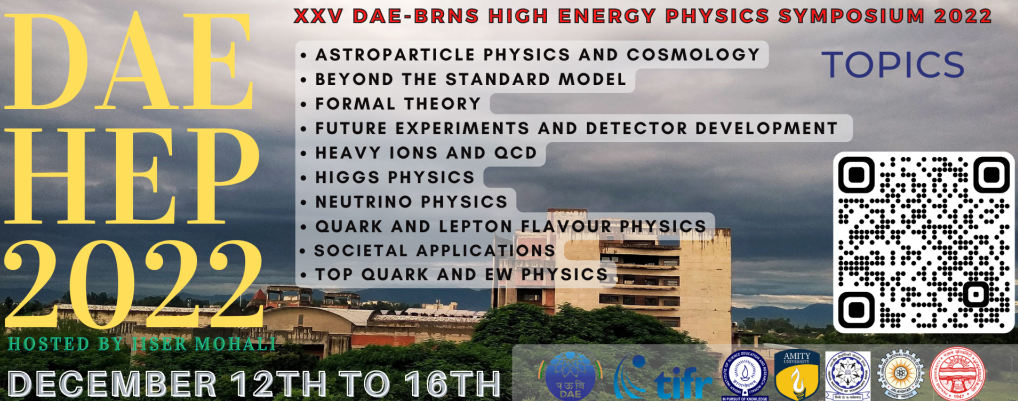Conveners
WG3-Formal Theory: D1-S2 - Parallel - 2
- Nabamita Banerjee
- Ayan Mukhopadhyay
WG3-Formal Theory: D2-S3 - Parallel - 2
- K.P. Yogendran
- Anosh Joseph
The Standard Model effective field theory (SMEFT) is one of the preferred approaches for studying particle physics in the present scenario. The dimension-six SMEFT operators are the most relevant ones and have been studied in various works. The renormalization group evolution equations of these operators are available in the literature and facilitate examining the SMEFT on combined...
We consider a black hole with a stretched horizon as a toy model for a fuzzball microstate. The stretched horizon provides a cut-off, and therefore one can determine the normal (as opposed to quasi-normal) modes of a probe scalar in this geometry. For the BTZ black hole, we compute these as a function of the level $n$ and the angular quantum number $J$. Though conventional level repulsion is...
We study a strongly coupled lattice model containing two flavors of massless staggered fermions interacting via two types of interactions: (1) a current- current interaction involving a four-fermi term of the same flavour, and (2) an on-site four-fermion interaction involving two flavours. We study the model at strong coupling, where both these interactions dominated over the free hoping term....
The critical behavior of the two-dimensional XY model has been explored in the literature using various methods. They include the high-temperature expansion (HTE) method, Monte Carlo (MC) approach, strong coupling expansion method, and tensor network (TN) methods. This model undergoes a Berezinskii-Kosterlitz-Thouless (BKT) type of phase transition. This model can be modified by adding...
Abstract: The primary ingredient for studying the phases of a quantum field theory is the effective action. Though obtaining an exact form is beyond the scope of the existing techniques, approximate expressions using perturbative methods which to the leading order involve computation of one-loop determinants are available. In the talk which is based on our paper [1], I will first describe...
A charged falling particle in an AdS space is studied as a holographic model of local charged quench. The evolution of holographic complexity in the conformal field theory following a local quench is studied using both the “complexity equals volume” (CV) and the “complexity equals action” (CA) conjectures in various models. The connection between operator size in chaotic theories and the bulk...
String theory lives in higher dimensions, and compactification of extra dimensions leads to many equivalent 4-d effective theories which potentially describe our universe. Hence, it is interesting to study this large set of 4-d models and their phenomenology in a statistical setup.
We focus on the statistical aspects of the type-IIB string landscape. We show that stabilization of kähler...
We apply the physically more appealing MIT Bag boundary conditions to study the Casimir effect on the lattice. Employing known formalism to calculate the Casimir energy for free lattice fermions, we show that the results for the naive, Wilson and overlap fermions match the continuum expressions precisely in the zero lattice spacing limit, as expected from universality. Furthermore, the...
In gauge theories and gravity, the scattering amplitudes of any number of external particles under the soft limit reduce to amplitudes with one less number of external particles times a universal soft factor. Higher-order interaction vertices (or scattering amplitudes) in a theory can be built up from the lower-order vertices (amplitudes) by using a multiplicative universal factor associated...
Feynman integrals at any order of perturbation, in the Lee-Pomeransky representation, could be realised as a subset of Euler-Mellin integrals. Such integrals are known to satisfy the Gelfand-Kapranov-Zelevinsky (GKZ) system of partial differential equations. In an ongoing collaboration, we automate the derivation of the associated GKZ-system for a given Feynman diagram from either its...
